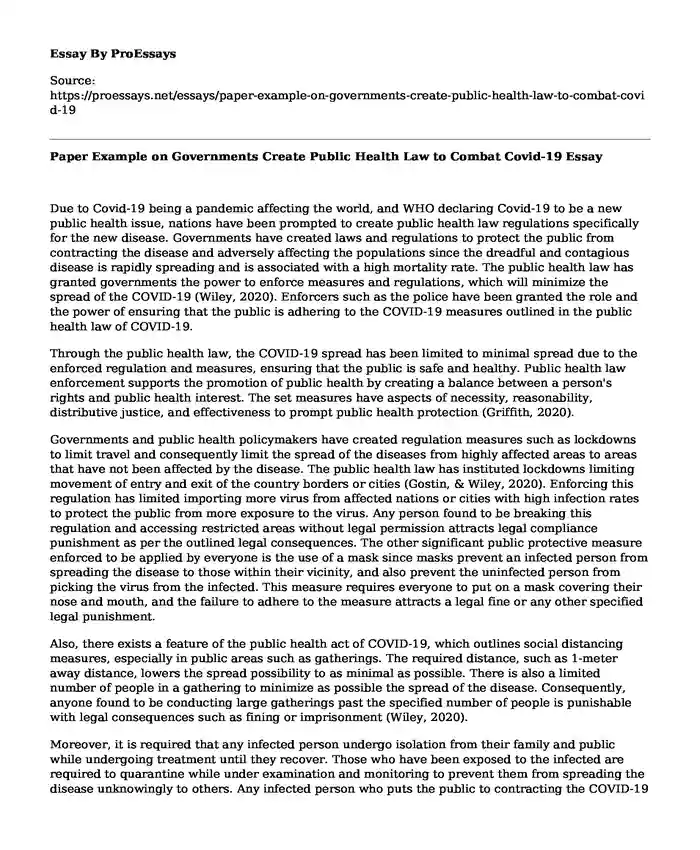Due to Covid-19 being a pandemic affecting the world, and WHO declaring Covid-19 to be a new public health issue, nations have been prompted to create public health law regulations specifically for the new disease. Governments have created laws and regulations to protect the public from contracting the disease and adversely affecting the populations since the dreadful and contagious disease is rapidly spreading and is associated with a high mortality rate. The public health law has granted governments the power to enforce measures and regulations, which will minimize the spread of the COVID-19 (Wiley, 2020). Enforcers such as the police have been granted the role and the power of ensuring that the public is adhering to the COVID-19 measures outlined in the public health law of COVID-19.
Through the public health law, the COVID-19 spread has been limited to minimal spread due to the enforced regulation and measures, ensuring that the public is safe and healthy. Public health law enforcement supports the promotion of public health by creating a balance between a person's rights and public health interest. The set measures have aspects of necessity, reasonability, distributive justice, and effectiveness to prompt public health protection (Griffith, 2020).
Governments and public health policymakers have created regulation measures such as lockdowns to limit travel and consequently limit the spread of the diseases from highly affected areas to areas that have not been affected by the disease. The public health law has instituted lockdowns limiting movement of entry and exit of the country borders or cities (Gostin, & Wiley, 2020). Enforcing this regulation has limited importing more virus from affected nations or cities with high infection rates to protect the public from more exposure to the virus. Any person found to be breaking this regulation and accessing restricted areas without legal permission attracts legal compliance punishment as per the outlined legal consequences. The other significant public protective measure enforced to be applied by everyone is the use of a mask since masks prevent an infected person from spreading the disease to those within their vicinity, and also prevent the uninfected person from picking the virus from the infected. This measure requires everyone to put on a mask covering their nose and mouth, and the failure to adhere to the measure attracts a legal fine or any other specified legal punishment.
Also, there exists a feature of the public health act of COVID-19, which outlines social distancing measures, especially in public areas such as gatherings. The required distance, such as 1-meter away distance, lowers the spread possibility to as minimal as possible. There is also a limited number of people in a gathering to minimize as possible the spread of the disease. Consequently, anyone found to be conducting large gatherings past the specified number of people is punishable with legal consequences such as fining or imprisonment (Wiley, 2020).
Moreover, it is required that any infected person undergo isolation from their family and public while undergoing treatment until they recover. Those who have been exposed to the infected are required to quarantine while under examination and monitoring to prevent them from spreading the disease unknowingly to others. Any infected person who puts the public to contracting the COVID-19 by exposing themselves to the public without taking any protection measures such as wearing masks is guilty of a legal offense outlined in the Public Health Act (Griffith, 2020). Breaking this law makes a person chargeable with a specific fine or imprisoned for the duration specified in the Act.
References
Gostin, L. O., & Wiley, L. F. (2020). Governmental public health powers during the COVID-19 pandemic: stay-at-home orders, business closures, and travel restrictions. Jama. https://jamanetwork.com/journals/jama/fullarticle/2764283
Griffith, R. (2020). Using public health law to contain the spread of COVID-19. British Journal of Nursing. https://www.magonlinelibrary.com/doi/full/10.12968/bjon.2020.29.5.326
Wiley, L. F. (2020). Public Health Law and Science in the Community Mitigation Strategy for Covid-19. Journal of Law and the Biosciences. https://academic.oup.com/jlb/article/doi/10.1093/jlb/lsaa019/5834622
Cite this page
Paper Example on Governments Create Public Health Law to Combat Covid-19. (2023, Sep 26). Retrieved from https://proessays.net/essays/paper-example-on-governments-create-public-health-law-to-combat-covid-19
If you are the original author of this essay and no longer wish to have it published on the ProEssays website, please click below to request its removal:
- Constitutional Amendments
- Case Study Example on Oral Self-care
- Student Activism in the Creation of Laws and Policies Essay
- The DASH Diet Mediterranean Solution Analysis Paper Example
- Research Paper on Problem or Issue Explored in The DNP Project
- Lateral Violence in Nursing: Dealing With Negative Attitudes - Essay Sample
- Transitions in the Informed Consents - Report Example







